10.10.2005
PEARL OF DAY №6: AS WITH GREENHORNS
By the middle of the tournament the participants have worked out the optimal format. And after all games of the 2nd round were drawn, Silvio Danailov said during the evening gathering that in spite of the favorable attitude of the understanding public to the chess content, it would be nice to increase the percentage of decisive games, because the championship also attracts general public used to think within the framework of binary «won-lost» notation. Out of respect to the rare species of chess managers grandmasters agreed to try it, but in two days begged, asking for indulgences and assuring that the absence of draws exhausts nervous system and hurts self-esteem. After thorough discussion, everyone came to the formula when Topalov wins and all other games end peacefully. Silvio made an immediate Gallup poll and ascertained that such situation suits both important politicians and businessmen on one hand and housewives on the other. This can be easily explained: a person who is not involved in it needs just one brain cell to keep up the conversation about contemporary chess, a simple surname being placed there, that has an additional association with the word «top».
The sixth round did not enlarge the collection of chess art masterpieces. However, returning to Anand-Adams game once again would be ridiculous. Moreover, the undisputed tournament leader was represented in the Pearl of the Day column only once with the game that ended in a draw. We will eliminate this injustice, just after a few words concerning other games.
It is pleasant that this time Petya confidently solved opening problems, kicking white color out of the hands of one of his most uncomfortable opponents. Kasimdzhanov and Leko played an exemplary but dull Sveshnikov variation. Rustam did not allow his opponent any counterplay, but unlike Anand did not create a passed pawn on the queenside. And a rook will never become queen, no matter how many times you move it along the open file. Adams and Morozevich played a very original game. Sasha gets the counterplay for the second game in a row with the same queen maneuvering on the c-file. Understanding people say that the position «two rooks and bishop against queen and knight» was unclear, and at some moment Mickey could even try for the advantage, but during the broadcast it seemed to me that with the help of the e4-pawn Black will certainly win at least exchange. It happened so as a matter of fact, but for another reason. Remaining in minority, White created a fortress, and in already classical «rook and pawn against queen» ending the opponents agreed to a draw, accepting Judit Polgar for their not very joyous company.
J.POLGAR-V.TOPALOV
1.e4 e5 2.¤f3 ¤c6 3.Ґb5 ¤f6. I will not call Veselin a subtle psychologist for using the Berlin Wall in the game with Judit the Sharpattacking. Rather it was Rustam who acted unskillfully by playing the Sicilian. Moreover, this opening had occurred in the games of these opponents previously. Let us not forget that the strongest female chess player won over Kasparov in the Berlin Variation. Veselin easily managed to win, but this only shows that in Argentina Polgar is far from the perfection that she really is.
4.0-0 ¤xe4 5.d4 ¤d6 6.Ґxc6 dxc6 7.dxe5 ¤f5 8.Јxd8+ ўxd8 9.¤c3 ¤e7 10.h3 ¤g6 11.¤e4 h6 12.b3 c5.
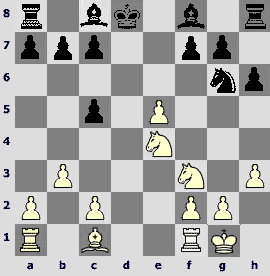
13.Ґe3. The last Black's move was an «official» novelty. Probably, Judit's reaction was not the best one. The bishop has nothing to do on e3 and will be retreated. It could be placed in the assigned b2-niche. There is also one more idea, but I will tell about it in the next annotation.
13...b6 14.¦ad1+ Ґd7 15.¤c3. Black's bishop is pinned for a moment, which makes one think about е5-е6 and ¤e5. To realize this idea one has to drive the knight away from the g6-square. But after 15.h4 ўc8 16.h5 ¤e7 the h5-pawn is a double-edged weapon: there is enough confirmation of this statement in the classical Caro-Kann. 15.e6?! fxe6 16.h4 looks thoughtless. And the operation with the pawn sacrifice on the 12th and 13th moves deserves attention (although one cannot say for sure that White gets anything noticeable). These are some sample lines: 13.¦d1+ Ґd7 14.e6 fxe6 15.h4 ўc8?! 16.h5 Ґc6 17.¦e1 ¤e7 18.¤xc5, or15...Ґe7 16.h5 ¤f8 17.Ґb2 ¦g8 18.¤e5 ўc8 19.¤xd7 ¤xd7 20.¦d3 c4 (20...¤f6 21.¤xf6 gxf6 22.¦ad1 ¦d8 23.¦xd8+ Ґxd8 24.Ґc1) 21.bxc4 ¤b6 22.¦g3, or15...h5 16.¤eg5. At the same time one has to remember that Black should not necessarily protect himself with the bishop, there is always a possibility to make the king retreat to the e8-square, and in this case it would be good for White to place the rooks on the d1 and e1 squares, and so he will have to lose the time and rearrange his pieces.
15...ўc8 16.¤d5 Ґe6 17.c4 ўb7 18.Ґc1 a5 19.a4 ¦d8. One can wonder once more what a strange opening it is. It seems that White made normal moves (in reply to c6-c5 everyone usually moves the knight to d5); it also happens that with the help of such natural moves players get not «plus-even», but a good advantage. And here there is nothing. And if the pawn were on f4 and not on f2, it is quite another matter, but for that one has to move the knight away from f3, and what about the e5-pawn? Black is ready to play c7-c6, exchange a couple of rooks and finally develop his kingside. Polgar does not bear the tension. The next White's move is hard to explain.
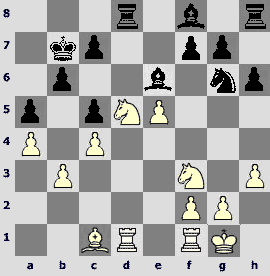
20.g4? h5! An absolutely standard reaction, to which one cannot but pay attention, and in this case one can see with a naked eye that White has difficulties with protecting the pawn that rushed forward inappropriately.
21.¤e3 ¦e8! A perfect move, fixing Black's advantage. In the ending after 21...¦xd1 22.¦xd1 ¤f4 23.¤g5 Ґe7 24.¤xe6 fxe6 25.gxh5 ¤xh3+ 26.ўg2 ¦xh5 27.ўg3 or 26...¤f4+ 27.ўf3 ¤xh5 28.ўg4 one would have to remember that one's advantage on the queenside is fairly smoothed away by the doubled pawns, and on the kingside White does not feel herself aggrieved. You can compare these variations with those mentioned in the annotation to the 26th move, and the difference will be obvious.
22.¦fe1. One can prevent the opponent's knight from jumping on f4 by only putting one's own from e3, or – in case of 22.¤f5 hxg4 23.hxg4 Ґxf5 24.gxf5 ¤xe5 – the е5-pawn.
22...¤f4 23.¤g5 Ґe7 24.¤xe6. An attempt to hold on tactics – 24.¤d5 fails because of 24...Ґxd5 25.Ґxf4 Ґxg5 26.Ґxg5 Ґf3 27.¦c1 (27.¦d3 hxg4 28.h4 f6) 27...hxg4 28.h4 ¦ef8 with subsequent f7-f6.
24...fxe6 25.gxh5 ¤xh3+ 26.ўf1. On 26.ўg2 both 26...¤f4+ 27.ўf3 ¦ef8 28.ўe4 ¦xh5, and 26...¦xh5 27.ўg3? (27.¤g4) 27...¦g5+ are possible. The presence of the second black rook influences the assessment substantially.
26...¦xh5 27.¤g4.
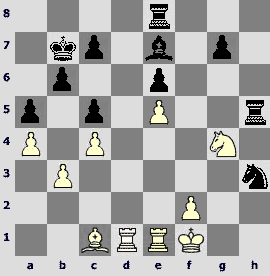
27...Ґg5! The bishop exchange secures the f4-square to the knight.
28.Ґxg5. It is not time to think about counterplay – 28.¦d7 Ґxc1 29.¦xc1 ¤f4 30.ўe1 ўc6 31.¦xg7? ¦d8.
28...¦xg5 29.f3 ¦f8 30.ўg2 ¤f4+ 31.ўg3 ¦h5. The prophylactic king move 31...ўc6 is also rather good, because one cannot make 32.¦h1? ¤e2+ and ¤d4 with winning of the second pawn. But even after the text move rooks are unable to use the open files. One can remember that Capablanca in his classical ending with the rooks and the knights against Lasker did not touch the king for a long time.
32.ўf2 (32.¦h1 ¦xh1 33.¦xh1 ¤e2+ 34.ўf2 ¤d4) 32...¤g6 33.¦d7 ¦h3 34.¦e3 ¤h4! And the rook that had broken free has to go, because the g7-pawn is poisoned by the fork 35.¦xg7 ¤f5.
35.¦dd3 ўc6.
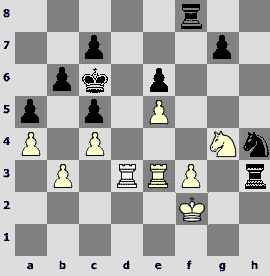
36.¦c3. White is almost in the complete Zugzwang, and it is good that she has this move at least. 36.ўe2 ¤f5 37.¦e4 ¤g3+ loses.
36...¦h1!? An attempt to strengthen the position by penetrating to the first rank. After 36...¦f4 Black could win a second pawn by capturing on f3 and g4, but Topalov still avoids rook ending with a passed pawn on the g-file. But the irony of this is that he finally got this very ending with additional white pawn on e4.
37.¦ed3 ¤f5. In case of 37...¦b1 38.¦e3 in answer to 38...¤f5 White can play 39.¦e1. This is the only way to avoid huge losses. Here 38.ўg2 will be met by a powerful 38...¦b1. Judit finds the defense.
38.¤e3 ¤d4 39.¤f1! ¦h5 40.¦e3 ¦f4 41.¦cd3 g5 42.¦e4.
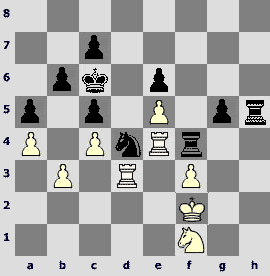
42...ўb7. The move looks rather strange. Black strengthens his position to the maximum. Now he is ready to make decisive moves. 42...¦h3!? 43.¤d2 ¦h2+ looked nice (43...¦h1 44.¤f1 ¦xf3+ 45.¦xf3 ¤xf3 46.¤g3 ¤d2 47.¤xh1 ¤xe4+ 48.ўe3 ¤c3 49.¤f2 is weaker, and in the knight ending White's pieces are far from action, the g5-pawn will be lost in a few moves) 44.ўg3 ¦xd2! 45.¦xd2 ¦xf3+ 46.ўg4 ¦xb3. Ok, maybe Veselin did not want to sacrifice the exchange...
43.ўg3 ¦xe4. And here 43...¤xf3! 44.¦xf4 ¤xe5 45.¦ff3 g4 46.¦fe3 ¦h3+ 47.ўg2 ¤xd3 was strong. And again we can understand Topalov – some combinations, witty intermediate moves... And in the end Black's advantage has decreased.
44.fxe4 ¦h4 45.¤d2 ўc8. 45...¤e2+ 46.ўf3 ¤c1 47.¦d8 ¤xb3 48.¤xb3 ¦h3+ 49.ўg4 ¦xb3 50.ўxg5 ¦b4 51.ўf6 ¦xc4 52.ўxe6 ¦xe4 with counterplay was bad technique, but maybe Black's victory can be proved in the analysis.
46.¦e3 ўd7 (one can get here from с6 in one move) 47.¦e1 (White finishes the preparation to the knight trade) 47...ўe7 48.¤f3 ¤xf3 49.ўxf3.

And we see the rook ending with its notable tendencies on board. Veselin plays it flawlessly.
49...ўf7! After 49...¦h3+ 50.ўg4 ¦xb3 51.¦h1 White, as in the variation to the 45th move, reached the e6-pawn. Topalov manages to bring king to help the passed pawn at the same time providing the defense of the 7th row pawns.
50.¦d1 ¦f4+ 51.ўe3. 51.ўg3 ¦xe4 52.¦d7+ ўg6 53.¦xc7 ўf5 54.ўf2 ўxe5 does not save.
51...ўg7 52.¦d7+ ¦f7 53.¦d1. The opponent's king is cut off, and the g-pawn starts moving. At the same time White gets the last possibility of the counterplay from the rear.
53...ўg6 54.¦d8 g4 55.¦g8+ ўh5 56.¦h8+ ўg5 57.¦g8+ ўh4 58.¦g6 ¦f3+ 59.ўe2.
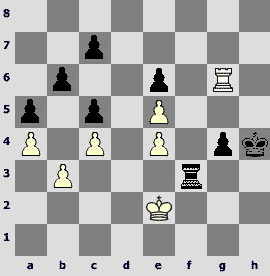
59...ўg3! A nice king maneuver neutralizes White's e-file pawns. It is a pity: they just started to feel themselves passed.
60.¦xe6 ўf4 61.¦e8 (61.¦f6+ ўxe4) 61...¦e3+ 62.ўf2. Или 62.ўd2 ¦xe4 63.e6 ўf5 64.e7 ўf6 65.ўd3 ¦xe7 66.¦xe7 ўxe7 67.ўe4 ўe6 68.ўf4 g3 69.ўxg3 ўe5. If the pawns are the heart of the chess game, then can we call this ending hearty? I understand this is a silly question.
62...g3+ 63.ўg2 ўxe4 64.e6 ўd3! The king hides from white rook in the middle of the pawn crowd, starting to thin it out by eating white pawns. Polgar acknowledged her defeat.
Maybe Black had some converting faults, but Topalov still played the game as a champion. But I will say that in a whisper because time did not come still...
